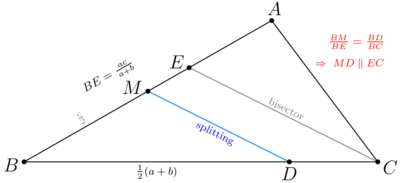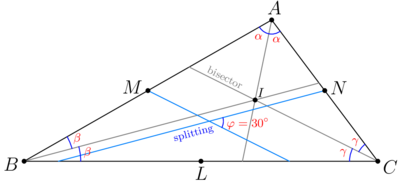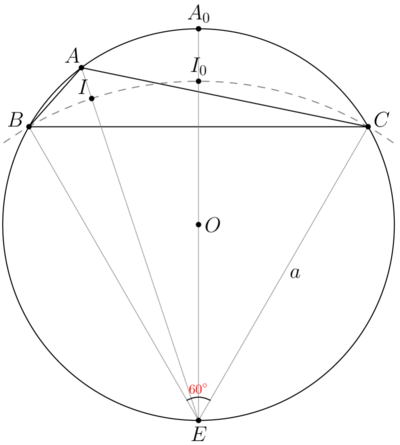Difference between revisions of "2022 AIME I Problems/Problem 14"
m (→Solution(Visual geometry)) |
Mathtiger6 (talk | contribs) m (→The NT Part) |
||
| Line 20: | Line 20: | ||
We now need to solve <math>a^2+ab+b^2 = 3^2\cdot 73^2</math>. A quick <math>(\bmod 9)</math> check gives that <math>3\mid a</math> and <math>3\mid b</math>. Thus, it's equivalent to solve <math>x^2+xy+y^2 = 73^2</math>. | We now need to solve <math>a^2+ab+b^2 = 3^2\cdot 73^2</math>. A quick <math>(\bmod 9)</math> check gives that <math>3\mid a</math> and <math>3\mid b</math>. Thus, it's equivalent to solve <math>x^2+xy+y^2 = 73^2</math>. | ||
| − | Let <math>\omega</math> be one root of <math>\omega^2+\omega+1=0</math>. Then, recall that <math>\mathbb Z[\omega]</math> is the ring of integers of <math>\mathbb Q[\sqrt{-3}]</math> and is a unique factorization domain. Notice that <math>N(x-y\omega) = (x-y\omega)(x-y\omega^2) = x^2 | + | Let <math>\omega</math> be one root of <math>\omega^2+\omega+1=0</math>. Then, recall that <math>\mathbb Z[\omega]</math> is the ring of integers of <math>\mathbb Q[\sqrt{-3}]</math> and is a unique factorization domain. Notice that <math>N(x-y\omega) = (x-y\omega)(x-y\omega^2) = x^2+xy+y^2</math>. Therefore, it suffices to find an element of <math>\mathbb Z[\omega]</math> with the norm <math>73^2</math>. |
To do so, we factor <math>73</math> in <math>\mathbb Z[\omega]</math>. Since it's <math>1\pmod 3</math>, it must split. A quick inspection gives <math>73 = (8-\omega)(8-\omega^2)</math>. Thus, <math>N(8-\omega) = 73</math>, so | To do so, we factor <math>73</math> in <math>\mathbb Z[\omega]</math>. Since it's <math>1\pmod 3</math>, it must split. A quick inspection gives <math>73 = (8-\omega)(8-\omega^2)</math>. Thus, <math>N(8-\omega) = 73</math>, so | ||
Latest revision as of 01:56, 4 January 2023
Contents
[hide]Problem
Given ![]() and a point
and a point ![]() on one of its sides, call line
on one of its sides, call line ![]() the
the ![]() of
of ![]() through
through ![]() if
if ![]() passes through
passes through ![]() and divides
and divides ![]() into two polygons of equal perimeter. Let
into two polygons of equal perimeter. Let ![]() be a triangle where
be a triangle where ![]() and
and ![]() and
and ![]() are positive integers. Let
are positive integers. Let ![]() and
and ![]() be the midpoints of
be the midpoints of ![]() and
and ![]() respectively, and suppose that the splitting lines of
respectively, and suppose that the splitting lines of ![]() through
through ![]() and
and ![]() intersect at
intersect at ![]() Find the perimeter of
Find the perimeter of ![]()
The Geometry Part - Solution 1
Consider the splitting line through ![]() . Extend
. Extend ![]() on ray
on ray ![]() such that
such that ![]() . Then the splitting line bisects segment
. Then the splitting line bisects segment ![]() , so in particular it is the midline of triangle
, so in particular it is the midline of triangle ![]() and thus it is parallel to
and thus it is parallel to ![]() . But since triangle
. But since triangle ![]() is isosceles, we can easily see
is isosceles, we can easily see ![]() is parallel to the angle bisector of
is parallel to the angle bisector of ![]() , so the splitting line is also parallel to this bisector, and similar for the splitting line through
, so the splitting line is also parallel to this bisector, and similar for the splitting line through ![]() . Some simple angle chasing reveals the condition is now equivalent to
. Some simple angle chasing reveals the condition is now equivalent to ![]() .
.
- MortemEtInteritum
The Geometry Part - Solution 2
Let ![]() and
and ![]() be the splitting lines. Reflect
be the splitting lines. Reflect ![]() across
across ![]() to be
to be ![]() and
and ![]() across
across ![]() to be
to be ![]() . Take
. Take ![]() and
and ![]() , which are spiral similarity centers on the other side of
, which are spiral similarity centers on the other side of ![]() as
as ![]() such that
such that ![]() and
and ![]() . This gets that because
. This gets that because ![]() and
and ![]() , then
, then ![]() and
and ![]() are on
are on ![]() 's circumcircle. Now, we know that
's circumcircle. Now, we know that ![]() and
and ![]() so because
so because ![]() and
and ![]() , then
, then ![]() and
and ![]() and
and ![]() and
and ![]() .
.
We also notice that because ![]() and
and ![]() correspond on
correspond on ![]() and
and ![]() , and because
, and because ![]() and
and ![]() correspond on
correspond on ![]() and
and ![]() , then the angle formed by
, then the angle formed by ![]() and
and ![]() is equal to the angle formed by
is equal to the angle formed by ![]() and
and ![]() which is equal to
which is equal to ![]() . Thus,
. Thus, ![]() . Similarly,
. Similarly, ![]() and so
and so ![]() and
and ![]() .
.
- kevinmathz
The NT Part
We now need to solve ![]() . A quick
. A quick ![]() check gives that
check gives that ![]() and
and ![]() . Thus, it's equivalent to solve
. Thus, it's equivalent to solve ![]() .
.
Let ![]() be one root of
be one root of ![]() . Then, recall that
. Then, recall that ![]() is the ring of integers of
is the ring of integers of ![]() and is a unique factorization domain. Notice that
and is a unique factorization domain. Notice that ![]() . Therefore, it suffices to find an element of
. Therefore, it suffices to find an element of ![]() with the norm
with the norm ![]() .
.
To do so, we factor ![]() in
in ![]() . Since it's
. Since it's ![]() , it must split. A quick inspection gives
, it must split. A quick inspection gives ![]() . Thus,
. Thus, ![]() , so
, so
 giving the solution
giving the solution ![]() and
and ![]() , yielding
, yielding ![]() and
and ![]() , so the sum is
, so the sum is ![]() . Since
. Since ![]() and
and ![]() are primes in
are primes in ![]() , the solution must divide
, the solution must divide ![]() . One can then easily check that this is the unique solution.
. One can then easily check that this is the unique solution.
- MarkBcc168
Solution (Geometry + Number Theory)
Denote ![]() ,
, ![]() ,
, ![]() .
.
Let the splitting line of ![]() through
through ![]() (resp.
(resp. ![]() ) crosses
) crosses ![]() at another point
at another point ![]() (resp.
(resp. ![]() ).
).
WLOG, we assume ![]() .
.
![]() :
: ![]() .
.
We extend segment ![]() to
to ![]() , such that
, such that ![]() .
We extend segment
.
We extend segment ![]() to
to ![]() , such that
, such that ![]() .
.
In this case, ![]() is the midpoint of
is the midpoint of ![]() , and
, and ![]() is the midpoint of
is the midpoint of ![]() .
.
Because ![]() and
and ![]() are the midpoints of
are the midpoints of ![]() and
and ![]() , respectively,
, respectively, ![]() .
Because
.
Because ![]() and
and ![]() are the midpoints of
are the midpoints of ![]() and
and ![]() , respectively,
, respectively, ![]() .
.
Because ![]() ,
, ![]() .
Because
.
Because ![]() ,
, ![]() .
.
Let ![]() and
and ![]() intersect at
intersect at ![]() .
Because
.
Because ![]() and
and ![]() , the angle formed between lines
, the angle formed between lines ![]() and
and ![]() is congruent to
is congruent to ![]() . Hence,
. Hence, ![]() or
or ![]() .
.
We have

Hence, we must have ![]() , not
, not ![]() .
Hence,
.
Hence, ![]() .
.
This implies ![]() and
and ![]() . This contradicts the condition specified for this case.
. This contradicts the condition specified for this case.
Therefore, this case is infeasible.
![]() :
: ![]() .
.
We extend segment ![]() to
to ![]() , such that
, such that ![]() .
We extend segment
.
We extend segment ![]() to
to ![]() , such that
, such that ![]() .
.
In this case, ![]() is the midpoint of
is the midpoint of ![]() , and
, and ![]() is the midpoint of
is the midpoint of ![]() .
.
Because ![]() and
and ![]() are the midpoints of
are the midpoints of ![]() and
and ![]() , respectively,
, respectively, ![]() .
Because
.
Because ![]() and
and ![]() are the midpoints of
are the midpoints of ![]() and
and ![]() , respectively,
, respectively, ![]() .
.
Because ![]() ,
, ![]() .
Because
.
Because ![]() ,
, ![]() .
.
Let ![]() be a point of
be a point of ![]() , such that
, such that ![]() .
Hence,
.
Hence, ![]() .
.
Because ![]() and
and ![]() and
and ![]() , the angle formed between lines
, the angle formed between lines ![]() and
and ![]() is congruent to
is congruent to ![]() . Hence,
. Hence, ![]() or
or ![]() .
.
We have

Hence, we must have ![]() , not
, not ![]() .
Hence,
.
Hence, ![]() .
.
This implies ![]() and
and ![]() . This contradicts the condition specified for this case.
. This contradicts the condition specified for this case.
Therefore, this case is infeasible.
![]() :
: ![]() .
.
We extend segment ![]() to
to ![]() , such that
, such that ![]() .
We extend segment
.
We extend segment ![]() to
to ![]() , such that
, such that ![]() .
.
In this case, ![]() is the midpoint of
is the midpoint of ![]() , and
, and ![]() is the midpoint of
is the midpoint of ![]() .
.
Because ![]() and
and ![]() are the midpoints of
are the midpoints of ![]() and
and ![]() , respectively,
, respectively, ![]() .
Because
.
Because ![]() and
and ![]() are the midpoints of
are the midpoints of ![]() and
and ![]() , respectively,
, respectively, ![]() .
.
Because ![]() ,
, ![]() .
Because
.
Because ![]() ,
, ![]() .
.
Because ![]() and
and ![]() , the angle formed between lines
, the angle formed between lines ![]() and
and ![]() is congruent to
is congruent to ![]() . Hence,
. Hence, ![]() or
or ![]() .
.
We have

Hence, we must have ![]() , not
, not ![]() .
Hence,
.
Hence, ![]() .
.
In ![]() , by applying the law of cosines, we have
, by applying the law of cosines, we have

Because ![]() , we have
, we have
![]()
Now, we find integer solution(s) of this equation with ![]() .
.
Multiplying this equation by 4, we get
![]()
Denote ![]() . Because
. Because ![]() ,
, ![]() .
.
Because ![]() ,
, ![]() .
Thus,
.
Thus, ![]() .
This implies
.
This implies ![]() .
.
We also have ![]() .
Hence,
.
Hence, ![]() .
This implies
.
This implies ![]() .
.
Denote ![]() and
and ![]() . Hence,
. Hence, ![]() .
Hence, Equation (1) can be written as
.
Hence, Equation (1) can be written as
![]()
Now, we solve this equation.
First, we find an upper bound of ![]() .
.
We have ![]() .
Hence,
.
Hence, ![]() .
Hence,
.
Hence, ![]() .
Because
.
Because ![]() is an integer, we must have
is an integer, we must have ![]() .
.
Second, we find a lower bound of ![]() .
.
We have ![]() .
Hence,
.
Hence, ![]() .
Hence,
.
Hence, ![]() .
Because
.
Because ![]() is an integer, we must have
is an integer, we must have ![]() .
.
Now, we find the integer solutions of ![]() and
and ![]() that satisfy Equation (2) with
that satisfy Equation (2) with ![]() .
.
First, modulo 9,

Hence ![]() .
.
Second, modulo 5,

Because ![]() , we must have
, we must have ![]() .
Hence,
.
Hence, ![]() .
.
Third, modulo 7,

Because ![]() , we must have
, we must have ![]() .
Hence,
.
Hence, ![]() .
.
Given all conditions above, the possible ![]() are 74, 83, 88, 92, 97, 101, 106, 109, 116, 118, 127.
are 74, 83, 88, 92, 97, 101, 106, 109, 116, 118, 127.
By testing all these numbers, we find that the only solution is ![]() .
This implies
.
This implies ![]() .
.
Hence, ![]() and
and ![]() .
Hence,
.
Hence, ![]() .
.
Therefore, the perimeter of ![]() is
is ![]() .
.
~Steven Chen (www.professorchenedu.com)
Solution (Number Theory Part)
We wish to solve the Diophantine equation ![]() . It can be shown that
. It can be shown that ![]() and
and ![]() , so we make the substitution
, so we make the substitution ![]() and
and ![]() to obtain
to obtain ![]() as our new equation to solve for.
as our new equation to solve for.
Notice that ![]() , where
, where ![]() . Thus,
. Thus,
![]()
Note that ![]() . Thus,
. Thus, ![]() . Squaring both sides yields
. Squaring both sides yields
![]() Thus, by
Thus, by ![]() ,
, ![]() is a solution to
is a solution to ![]() . This implies that
. This implies that ![]() and
and ![]() , so our final answer is
, so our final answer is ![]() .
.
~ Leo.Euler
Solution(Visual geometry)
We look at upper and middle diagrams and get ![]() .
.
Next we use only the lower Diagram. Let ![]() be incenter
be incenter ![]() , E be midpoint of biggest arc
, E be midpoint of biggest arc ![]() Then bisector
Then bisector ![]() cross circumcircle
cross circumcircle ![]() at point
at point ![]() . Quadrilateral
. Quadrilateral ![]() is cyclic, so
is cyclic, so
![]()
![]()
![]() is integer.
is integer.
![]()
![]() A quick
A quick ![]() check gives that
check gives that ![]() and
and ![]() .
.
![]() Denote
Denote ![]()
We have equations in integers
![]()
The solution ![]() is
is
![]() Suppose,
Suppose, ![]()
Now we check all possible ![]()
Case ![]()
Case ![]()
Case ![]()
Case ![]()
Case ![]()
Case ![]()
vladimir.shelomovskii@gmail.com, vvsss
Video Solution
~MathProblemSolvingSkills.com
Video Solution
https://www.youtube.com/watch?v=kkous52vPps&t=3023s
~Steven Chen (wwww.professorchenedu.com)
Animated Video Solution
~Star League (https://starleague.us)
See Also
| 2022 AIME I (Problems • Answer Key • Resources) | ||
| Preceded by Problem 13 |
Followed by Problem 15 | |
| 1 • 2 • 3 • 4 • 5 • 6 • 7 • 8 • 9 • 10 • 11 • 12 • 13 • 14 • 15 | ||
| All AIME Problems and Solutions | ||
The problems on this page are copyrighted by the Mathematical Association of America's American Mathematics Competitions. ![]()












